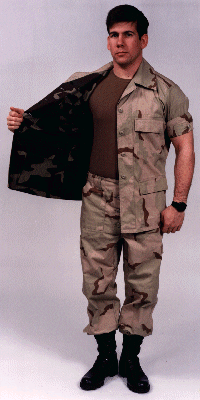The concept of separate uniforms for garrison and combat have been thrown out there several times over the past few years and we are basically already the now with the ACU and distinct ACS and ACP (if it’s ever fielded). I originally wrote this as a letter to the Editor of Infantry magazine in November of 1994. It was posted to the Gear Guru for many years and I shared it here on SSD on February 15, 2012 as “Me and My Good Ideas – Ha!”. I’ve got good reason to share it again now as the concept for a solid colored fatigue uniform has popped back up.
Yeah, it’s pretty tame by today’s standards, and some of the terminology is dated, but the basic concept is there.
At the end, I’ve also included a photo of the reversible camouflage technology demonstrated by Natick back in the 90s.
To: Editor
INFANTRY Magazine
Ft Benning, GA 31995-2005
19 November, 1994
Dear Editor,
I am presently serving in Haiti and feel the Battle Dress Uniform (BDU) is seriously lacking as a field uniform. In fact, during my eight years in the Army I have found the BDU woefully inadequate as both a garrison and combat uniform. Because it is a compromise between these two roles it does neither well. It’s hot, doesn’t stand up to pressing well, doesn’t provide adequate protection from the environment, isn’t compatible with other Clothing and Individual Equipment (CIE) items, as well as a myriad of other problems too numerous to mention here. What’s needed are two separate uniforms. First, a Garrison Dress Uniform (GDU) and second, a Generation II BDU.
The GDU is intended to be worn as a day-to-day uniform in classrooms and offices, while performing details, and during local tactical training such as land navigation. It’s manufactured from a comfortable, durable fabric that can be pressed for daily wear. The GDU’s jacket has two chest pockets and is cut bush style to allow the bottom of the jacket to be worn in or out of the trousers depending on the weather. Tucking the jacket in will show off the belt and provide an incentive to maintain a trim military appearance. The jacket’s long sleeves feature an upper arm pocket for pens and other items. The GDU trousers retain the present design of the BDU trouser while eliminating the leg ties and bug flap. Because the GDU is designed as a garrison uniform, the double elbows, seat, and knees found on the BDU are eliminated. The IR treatment is also not necessary. The simplification of construction allows the GDU to be issued as part of the Soldier’s clothing bag at a great savings. Since it’s designed to be pressed the GDU has a longer service life than the BDU.
The GEN II BDU is configured for wear on the battlefield and issued at the unit as TA-50 to be worn only in a field environment. It will last thirty days under combat conditions. The GEN II BDU must be abrasion resistant, fire retardant, wind proof, hydrophobic (water hating), permeable to allow sweat vapor to escape, treated to retard the growth of odor causing bacteria, and incorporate anti-IR coating. Unlike the present BDU, it’s compatible with insulating underlayers as well as outer layers such as ECWCS. The material features a reversible camouflage pattern so that one uniform is functional in several theaters. Twice in the last four years American Soldiers have deployed to the middle east wearing woodland BDUs which provided no camouflage in that region. Had their uniforms been reversible they would have arrived better prepared to fight. The GEN II BDU jacket is designed to interface with other CIE items. In lieu of the front opening found on the current BDU, the GEN II BDU has covered slide fasteners that begin at the bottom hem and go up under the arm to form pit zips for ventilation. The side zips will interface with the ECWCS parka as well as Ranger Body Armor (RBA). The jacket’s two chest pockets are accessible while in the prone. A lack of lower pockets enables the jacket to be tucked in for rappelling or parachuting. The jacket has waterproof/breathable elbow panels which serve as pockets for removable padding to be used for FIBUA, parachuting, or long periods in the prone. Each sleeve has a forward slanting pocket capable of holding one 30 rd M-16 magazine. These will be the only pockets readily accessible while wearing armor. The jacket’s standup collar incorporates a hide away hood which will protect the wearer’s head and neck from the elements as well as flashburns.
The trousers resemble the present field pants with several modifications. The are no rear pockets and the seat features a waterproof/breathable panel. Waterproof/Breathable panels are also found on the knees which accept removable padding. Trouser legs feature covered overboot zippers presently found on the CPOG to facilitate rapid donning and doffing. The legs will also interface with a waterproof/breathable gaiter to keep water from entering the tops of boots.
Adoption of these two uniforms gives the Soldier an inexpensive uniform for garrison wear which projects a positive military image and a combat uniform optimized for wear on the modern battlefield. The cost savings will be felt immediately as only those Soldiers who need combat uniforms for their duties will receive them. The garrison uniform will be less expensive to manufacture than the current BDU as well as better suited to pressing which will give it a longer service life.

















































































































